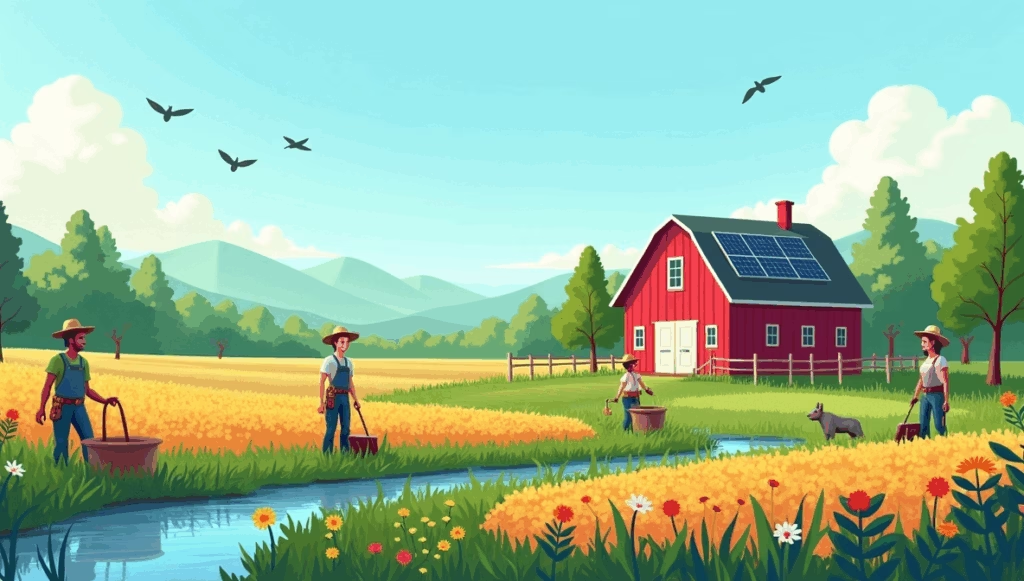Canada is one of the world’s leading agricultural producers, known for its vast farmlands, fertile soils, and advanced farming technologies. However, with climate change, soil degradation, and environmental challenges, sustainable farming in Canada has become a top priority.

Sustainable farming refers to agricultural methods that balance food production, environmental protection, and farmer profitability. In Canada, this means adopting practices that conserve soil, reduce chemical use, cut carbon emissions, and support rural communities.
For beginners, you may also check our detailed guide on Modern Farming Techniques in USA to understand how innovation supports sustainability worldwide.
Why Sustainable Farming Matters in Canada
- Climate Change: Canadian farmers face rising temperatures, unpredictable rainfall, and extreme weather. Environment and Climate Change Canada highlights agriculture’s role in tackling climate change.
- Soil Health: Long-term monocropping and chemical use reduce soil fertility. Sustainable farming restores soil life.
- Water Conservation: Agriculture accounts for about 70% of freshwater use (FAO report). Efficient irrigation and water management are crucial.
- Economic Stability: Consumers are demanding eco-friendly and organic food, opening new markets for farmers.
Key Sustainable Farming Practices in Canada
1. Crop Rotation & Diversification
- Planting different crops (e.g., wheat, canola, pulses, barley) improves soil fertility and breaks pest cycles.
- Reduces dependency on chemical fertilizers.
2. Conservation Tillage
- Minimal soil disturbance helps retain moisture and prevent erosion.
- Common in the Prairie Provinces (Saskatchewan, Alberta, Manitoba).
3. Organic Farming
- Canada has a growing organic sector worth $8+ billion annually (Canada Organic Trade Association).
- No synthetic fertilizers or pesticides – focuses on natural compost and biological pest control.
You can also explore our article on Best Compost for Terrace Gardening in India to learn how composting helps in soil enrichment worldwide.
4. Cover Cropping
- Planting legumes, clover, or ryegrass between main crops to enrich soil nitrogen.
- Prevents weed growth and enhances biodiversity.
5. Water-Efficient Irrigation
- Use of drip irrigation and precision sprinklers in dry areas.
- Especially useful in British Columbia and Alberta where water stress is higher.
6. Precision Agriculture
- GPS, drones, and AI help farmers apply fertilizers and water only where needed.
- Agriculture and Agri-Food Canada promotes precision agriculture as a climate-smart solution.
7. Agroforestry
- Integrating trees with farmland protects soil, provides shade, and improves carbon capture.
Canadian Government Support for Sustainable Farming
The Canadian government and organizations actively support farmers in adopting eco-friendly practices:
- Canadian Agricultural Partnership (CAP): Provides funding for sustainable agriculture projects (Government of Canada – CAP).
- On-Farm Climate Action Fund: Supports practices like cover cropping, rotational grazing, and nitrogen management.
- Sustainable Canadian Agricultural Partnership (2023–2028): $3.5 billion program focusing on climate-smart agriculture.
Benefits of Sustainable Farming in Canada
- Environmental Protection – Reduces greenhouse gases and soil degradation.
- Economic Growth – Access to premium organic and eco-friendly markets.
- Better Yields Long-term – Healthy soil ensures productivity for future generations.
- Consumer Trust – Canadians are increasingly choosing sustainably produced food.
Challenges in Sustainable Farming
- High Initial Costs: Equipment like drip irrigation or drones can be expensive.
- Knowledge Gap: Farmers need training and awareness about sustainable practices.
- Climate Risks: Droughts, floods, and pests still pose challenges despite eco-friendly practices.
- Market Uncertainty: Organic and sustainable produce often faces pricing fluctuations.
Future of Sustainable Farming in Canada
- Carbon Credit Opportunities: Farmers adopting sustainable practices may earn income by selling carbon credits (FAO Carbon Markets).
- Smart Farming Technologies: AI, robotics, and IoT will enhance efficiency.
- Export Growth: Global demand for sustainable Canadian produce is rising.
- Youth in Farming: Sustainable farming attracts young entrepreneurs interested in technology-driven agriculture.
FAQs on Sustainable Farming in Canada
Q1: What crops are most suitable for sustainable farming in Canada?
Wheat, canola, pulses, barley, and organic vegetables are commonly grown under sustainable systems.
Q2: Is organic farming the same as sustainable farming?
Not exactly. Organic farming avoids chemicals, while sustainable farming focuses on balancing productivity, ecology, and economics.
Q3: How much of Canadian farmland is organic?
Around 3 million acres are certified organic in Canada.
Q4: Which province leads in sustainable farming?
Saskatchewan and Alberta lead in conservation tillage, while British Columbia is strong in organic farming.
Q5: Does the Canadian government support sustainable farming?
Yes, through programs like CAP and the Sustainable CAP (2023–2028).
Conclusion
Sustainable farming in Canada is no longer an option – it is a necessity. By adopting eco-friendly practices like crop rotation, precision agriculture, and organic farming, Canadian farmers can protect the environment while staying profitable. With government support and consumer demand for green food, the future of farming in Canada looks both sustainable and prosperous.
To expand your knowledge on eco-friendly agriculture, don’t miss our article on Composting at Home – Step by Step where we explain how small changes in waste management can support sustainability.
Related Articles You May Like (Internal):





